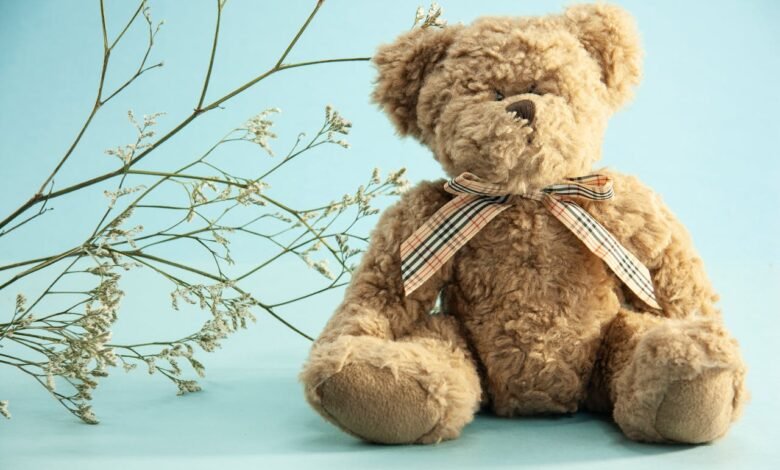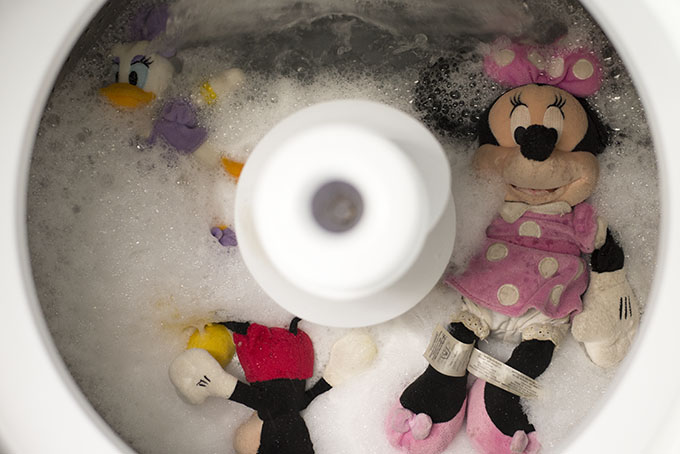How to Wash Stuffed Animals: Ultimate Care Guide

To wash stuffed animals, place them in a pillowcase, tie it closed, and wash on a gentle cycle. Air dry.
Cleaning stuffed animals is essential to keep them fresh and hygienic, especially for children who play with them regularly. Whether your child’s favorite teddy bear needs a refresh or a decorative stuffed toy requires cleaning, it’s important to know the proper steps to wash them effectively.
By following these simple guidelines, you can ensure that your stuffed animals remain clean, fluffy, and ready for more cuddles. Let’s explore the easy and safe methods for washing stuffed animals to maintain their quality and keep them looking their best for years to come.
Introduction To Stuffed Animal Care
The Importance Of Keeping Them Clean
Regular cleaning is essential to maintain the hygiene and longevity of stuffed animals, especially for children who often cuddle with their favorite toys. Clean toys can help prevent the spread of germs and allergens, promoting a healthier environment for your little ones.
Common Challenges In Washing Stuffed Toys
Washing stuffed toys can present challenges, as improper cleaning methods can damage the fabric, distort the shape, or cause the colors to bleed. Additionally, some stuffed animals may have delicate parts or electronic components that require special care during the cleaning process.
Identifying The Material
To wash stuffed animals effectively, start by identifying the material. Check the tag for washing instructions before proceeding with the appropriate cleaning method.
Identifying the Material: Before washing a stuffed animal, it’s essential to identify the material it’s made of. Different materials require different washing methods, and using the wrong technique can damage the toy. Here are some steps to help you identify the material of your stuffed animal: Reading Labels for Fabric Types: Most stuffed animals come with labels that indicate the materials used to make them. The label may also include washing instructions. If the label is still attached to the toy, check it to see if it provides any information on the material. Here are some common materials used to make stuffed animals: – Polyester – Cotton – Acrylic – Wool – Faux fur – Silk Special Considerations for Different Materials: Once you’ve identified the material, it’s essential to consider any special care instructions that may apply. For example, if the stuffed animal is made of wool, it may need to be hand washed in cold water to prevent shrinking. On the other hand, if the toy is made of polyester, it may be safe to wash it in a washing machine. Here are some special considerations for different materials: – Polyester: Can usually be washed in a washing machine on a gentle cycle. – Cotton: Can be washed in a washing machine on a regular cycle. – Acrylic: Can be washed in a washing machine on a gentle cycle. – Wool: Usually needs to be hand washed in cold water to prevent shrinking. – Faux fur: Can usually be washed in a washing machine on a gentle cycle. – Silk: Usually needs to be dry cleaned. In conclusion, identifying the material of your stuffed animal is crucial before attempting to wash it. Reading the label for fabric types and considering any special care instructions for different materials can help ensure that the toy is cleaned properly without causing any damage.
Pre-wash Preparations
Prepare stuffed animals for washing by carefully inspecting for any loose seams or embellishments. Place them in a pillowcase or laundry bag to protect them during the wash. Use a gentle detergent and wash on a delicate cycle to keep them looking their best.
Before washing your stuffed animals, it is important to take some preparatory steps to ensure a successful cleaning process. Here are some essential pre-wash preparations to follow: 1. Spot Cleaning Techniques: If your stuffed animal has small stains or dirt marks, it is best to start by spot cleaning those areas. Use a damp cloth or sponge and a mild detergent to gently dab at the stains. Avoid rubbing vigorously, as this may damage the fabric or cause colors to bleed. Once the stains are treated, allow the stuffed animal to air dry completely before proceeding to the next step. 2. Removing Batteries and Sound Mechanisms: Many stuffed animals come with batteries or sound mechanisms, which may not be waterproof. Before washing, it is crucial to remove these components to prevent damage. Look for openings or Velcro closures that provide access to the batteries or sound mechanisms. Carefully detach or unfasten them and set them aside in a safe place. 3. Check for Loose Parts: Inspect the stuffed animal for any loose parts that could be damaged during the washing process. This includes buttons, bows, or any other small accessories. If there are any detachable parts, remove them and set them aside for safekeeping. For parts that are sewn onto the stuffed animal, reinforce them with a few stitches if they feel loose. 4. Read the Care Instructions: Before proceeding with washing, it is important to check the care instructions provided by the manufacturer. Look for any specific guidelines, such as water temperature limits or hand-washing recommendations. Following these instructions will help ensure that your stuffed animal remains in good condition after washing. 5. Choose the Right Washing Method: Depending on the material and condition of your stuffed animal, you can choose between hand-washing or machine-washing. Hand-washing is generally gentler and allows for more control, especially for delicate or antique stuffed animals. Machine-washing, on the other hand, can be more convenient for larger or more durable stuffed animals. Consider the factors mentioned above and choose the most suitable method accordingly. Remember, proper pre-wash preparations are crucial to maintain the quality and appearance of your stuffed animals. Taking the time to spot clean, remove batteries and sound mechanisms, check for loose parts, read the care instructions, and select the appropriate washing method will help ensure a successful cleaning process. Now that you’re prepared, let’s move on to the actual washing techniques for stuffed animals.

Credit: sapulpalaundry.com
Hand Washing Method
When it comes to washing stuffed animals, the hand washing method is gentle and effective, ensuring your plush friends stay clean and cuddly for years to come.
Choosing The Right Detergent
1. Select a mild and gentle detergent to avoid harsh chemicals that could damage the fabric of the stuffed animals.
2. Avoid bleach or fabric softeners as they can cause discoloration or leave a residue on the plush toys.
Step-by-step Guide To Hand Washing
1. Prepare a basin of lukewarm water and add a small amount of mild detergent.
2. Submerge the stuffed animal in the soapy water and gently agitate it to loosen any dirt or grime.
3. Use a soft-bristled brush to gently scrub any stubborn stains or soiled areas.
4. Rinse the stuffed animal thoroughly with clean water until all the soap is removed.
5. Gently squeeze out excess water without twisting or wringing the plush toy.
6. Air dry the stuffed animal by laying it flat on a clean towel, ensuring it is completely dry before returning it to its rightful place.
Machine Washing Tips
To properly wash stuffed animals, follow these tips: place the stuffed animal in a pillowcase or laundry bag, use a gentle cycle with cold water, and opt for a mild detergent. After washing, let it air dry or use a low heat setting in the dryer.
Remember to remove any batteries or electronics before washing.
When it comes to washing stuffed animals, using a washing machine can be a convenient and efficient method. However, it is essential to follow some machine washing tips to ensure the safety and cleanliness of your beloved plush toys. In this section, we will discuss two important aspects: setting the correct wash cycle and protecting your stuffed animal in the machine.
Setting The Correct Wash Cycle
Choosing the right wash cycle is crucial to prevent any damage to your stuffed animals during the cleaning process. Follow these steps to ensure you set the correct wash cycle:
- Check the care label: Before placing your stuffed animal in the washing machine, always refer to the care label attached. The label will provide instructions on the appropriate wash cycle and temperature.
- Delicate or gentle cycle: In most cases, stuffed animals require a gentle or delicate wash cycle. This cycle is designed to be less aggressive and minimize the risk of damage to the toy.
- Low or cold temperature: To further protect your stuffed animals, it is advisable to use a low or cold temperature setting. High temperatures can cause the fabric to shrink or lose its shape.
Protecting Your Stuffed Animal In The Machine
To ensure your stuffed animal remains intact and clean throughout the machine washing process, consider the following tips:
- Place the stuffed animal in a mesh laundry bag: This will provide an extra layer of protection during the wash cycle, preventing any small parts from getting caught or torn.
- Use mild detergent: Opt for a gentle, non-bleach detergent specifically formulated for delicate fabrics. Harsh chemicals can damage the fabric and affect the appearance of the stuffed animal.
- Avoid mixing with other items: When washing your stuffed animal, it’s best to wash it separately from other clothing items to prevent potential tangling or snagging.
By following these machine washing tips, you can maintain the cleanliness and longevity of your stuffed animals without compromising their appearance or structural integrity.
Drying Your Stuffed Animals
When it comes to washing stuffed animals, it’s crucial to ensure proper drying to maintain their shape and prevent mildew. Drying your stuffed animals the right way will help them stay clean and fluffy, ready for lots of hugs and snuggles.
Air Drying Vs. Machine Drying
Air drying and machine drying are the two main methods for drying stuffed animals after washing. Air drying is the gentler option, especially for delicate or vintage stuffed animals. Machine drying, on the other hand, can be quicker but may cause damage if not done carefully.
Ensuring Thorough Drying To Prevent Mildew
To prevent mildew, it’s crucial to ensure thorough drying for your stuffed animals. After washing, gently squeeze out excess water and then use a clean, dry towel to pat them dry. Ensure that the entire stuffed animal, including any inner padding, is completely dry before returning it to its usual spot.
Maintaining Shape And Softness
Maintaining Shape and Softness
Proper care is essential to keep your stuffed animals looking fresh and feeling cuddly. Following the right washing techniques can help maintain their shape and softness for years to come.
Fluffing Techniques Post-wash
After washing, ensure to fluff up your stuffed animals to restore their original shape and fluffiness.
- Gently shake the stuffed animal to redistribute the filling evenly.
- Use a soft-bristled brush to fluff up the fur or fabric.
- If the toy has flattened areas, gently massage and reshape them with your hands.
Storing Stuffed Animals Properly
Proper storage is key to preserving the shape and softness of your stuffed animals.
| Storage Tips: | Details: |
|---|---|
| Avoid direct sunlight | to prevent fading and damage. |
| Keep in a dry place | to prevent mold and mildew growth. |
| Store in a breathable container | to allow air circulation. |
By following these care tips, you can ensure that your stuffed animals maintain their shape and softness for a long time.

Credit: celsious.com
Dealing With Tough Stains And Odors
When washing stuffed animals, tackling tough stains and pesky odors can be a challenge. Here’s how you can effectively deal with them:
Natural Remedies For Stubborn Stains
- Use white vinegar and baking soda paste for stains.
- Apply lemon juice directly on stains for a natural solution.
- Try hydrogen peroxide for tougher stains like blood.
Eliminating Odors Without Washing
- Baking soda absorbs odors – just sprinkle and let it sit.
- Essential oils on a cloth can freshen without washing.
- Activated charcoal absorbs odors effectively.
Safety Tips And Considerations
When washing stuffed animals, it’s crucial to keep safety tips and considerations in mind. Following these guidelines ensures that the cleaning process is effective and safe for your child’s beloved toys.
When To Avoid Water Washing
Avoid washing stuffed animals with electronic components to prevent damage.
Spot cleaning is recommended for delicate or antique stuffed animals.
Check the care label for specific washing instructions to avoid damaging the toy.
Consulting A Professional For Delicate Stuffed Animals
For delicate or sentimental stuffed animals, consider seeking professional cleaning services.
A professional can provide specialized care to preserve the integrity of the toy.
Consulting a specialist ensures that unique materials are handled correctly.

Credit: www.reddit.com
Frequently Asked Questions
How Often Should You Wash Stuffed Animals?
It is recommended to wash stuffed animals every 2-3 months to maintain cleanliness and prevent allergens from building up. However, if the stuffed animal is visibly dirty or has been exposed to illness, it should be washed immediately.
Can You Put Stuffed Animals In The Washing Machine?
Yes, most stuffed animals can be safely washed in the washing machine. However, it is important to check the care instructions on the toy’s label before washing. Use a gentle cycle and place the stuffed animal in a pillowcase or laundry bag for added protection.
How Do You Hand Wash A Stuffed Animal?
To hand wash a stuffed animal, fill a basin with warm water and a mild detergent. Gently submerge the toy and use a soft brush or cloth to clean its surface. Rinse thoroughly and squeeze out excess water. Air dry the stuffed animal, avoiding direct sunlight.
Can You Dry Clean Stuffed Animals?
Some stuffed animals may be labeled as dry clean only. In this case, it is best to take the toy to a professional cleaner who specializes in cleaning delicate items. They will have the necessary expertise to clean the stuffed animal without causing any damage.
Conclusion
After reading this guide, washing your stuffed animals at home should no longer be an intimidating task. Remember to always check the care label, spot clean before washing, and choose the proper washing machine setting. Hand washing and air drying are also great options for more delicate stuffed animals.
By following these tips, you can ensure that your stuffed animals stay clean, fresh, and safe for your little ones to play with. Happy washing!



